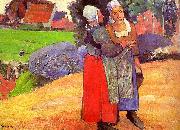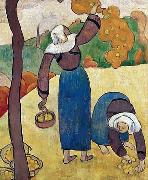
Oil On
Canvas, Real Flavor of Old Masters
|
Paul Gauguin
|
|||
|
|
|||
| French 1848-1903 Paul Gauguin Art Locations (born June 7, 1848, Paris, France ?? died May 8, 1903, Atuona, Hiva Oa, Marquesas Islands, French Polynesia) French painter, sculptor, and printmaker. He spent his childhood in Lima (his mother was a Peruvian Creole). From c. 1872 to 1883 he was a successful stockbroker in Paris. He met Camille Pissarro about 1875, and he exhibited several times with the Impressionists. Disillusioned with bourgeois materialism, in 1886 he moved to Pont-Aven, Brittany, where he became the central figure of a group of artists known as the Pont-Aven school. Gauguin coined the term Synthetism to describe his style during this period, referring to the synthesis of his paintings formal elements with the idea or emotion they conveyed. Late in October 1888 Gauguin traveled to Arles, in the south of France, to stay with Vincent van Gogh. The style of the two men work from this period has been classified as Post-Impressionist because it shows an individual, personal development of Impressionism use of colour, brushstroke, and nontraditional subject matter. Increasingly focused on rejecting the materialism of contemporary culture in favour of a more spiritual, unfettered lifestyle, in 1891 he moved to Tahiti. His works became open protests against materialism. He was an influential innovator; Fauvism owed much to his use of colour, and he inspired Pablo Picasso and the development of Cubism. | |||
|
|
|||
|
|
Breton Peasants Paul Gauguin47.jpg Painting ID:: 1377 Visit European Gallery |
1894 26 x 36 1/4 in. (66 x 92 cm) Musee d'Orsay, Paris | |
Height Width |
INS/CM |
||
|
X |
|
||
|
|
|||
|
Emile Bernard
|
|||
|
|
|||
| 1868-1941 French Emile Bernard Galleries (b Lille, 28 April 1868; d Paris, 15 April 1941). French painter and writer. He was the son of a cloth merchant. Relations with his parents were never harmonious, and in 1884, against his fathers wishes, he enrolled as a student at the Atelier Cormon in Paris. There he became a close friend of Louis Anquetin and Toulouse-Lautrec. In suburban views of Asnires, where his parents lived, Bernard experimented with Impressionist and then Pointillist colour theory, in direct opposition to his masters academic teaching; an argument with Fernand Cormon led to his expulsion from the studio in 1886. He made a walking tour of Normandy and Brittany that year, drawn to Gothic architecture and the simplicity of the carved Breton calvaries. In Concarneau he struck up a friendship with Claude-Emile Schuffenecker and met Gauguin briefly in Pont-Aven. During the winter Bernard met van Gogh and frequented the shop of the colour merchant Julien-Franois Tanguy, where he gained access to the little-known work of Cezanne. | |||
|
|
|||
|
|
Breton peasants new25/Emile Bernard-559786.jpg Painting ID:: 91405 Visit European Gallery |
Oil on canvas, 55.3 x 46.4 cm. Painted circa 1889 cjr | |
Height Width |
INS/CM |
||
|
X |
|
||
|
|
|||








